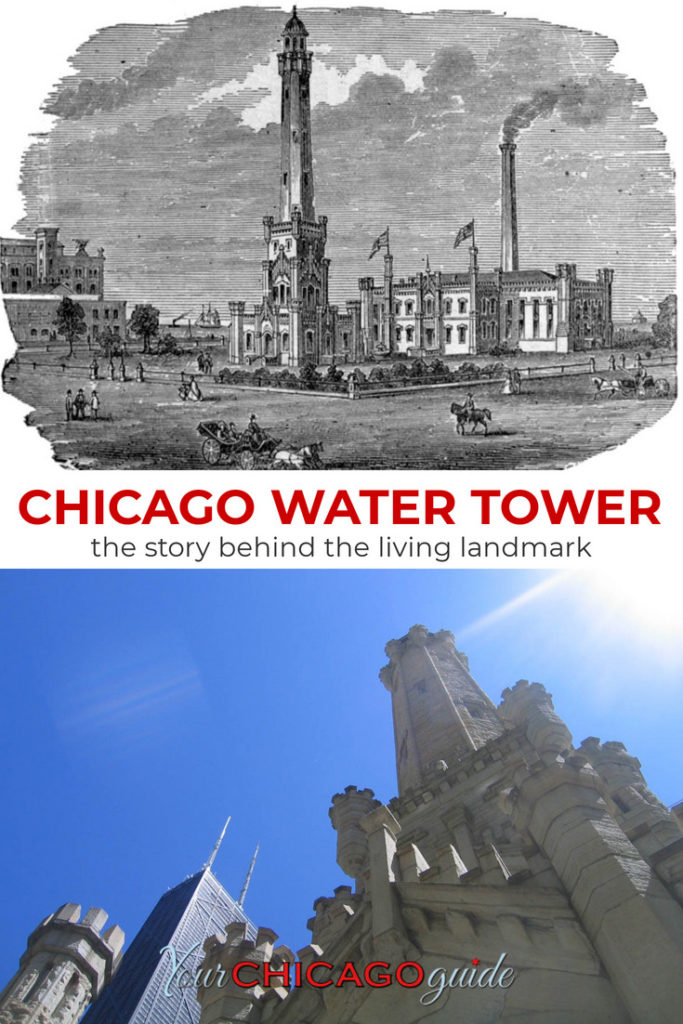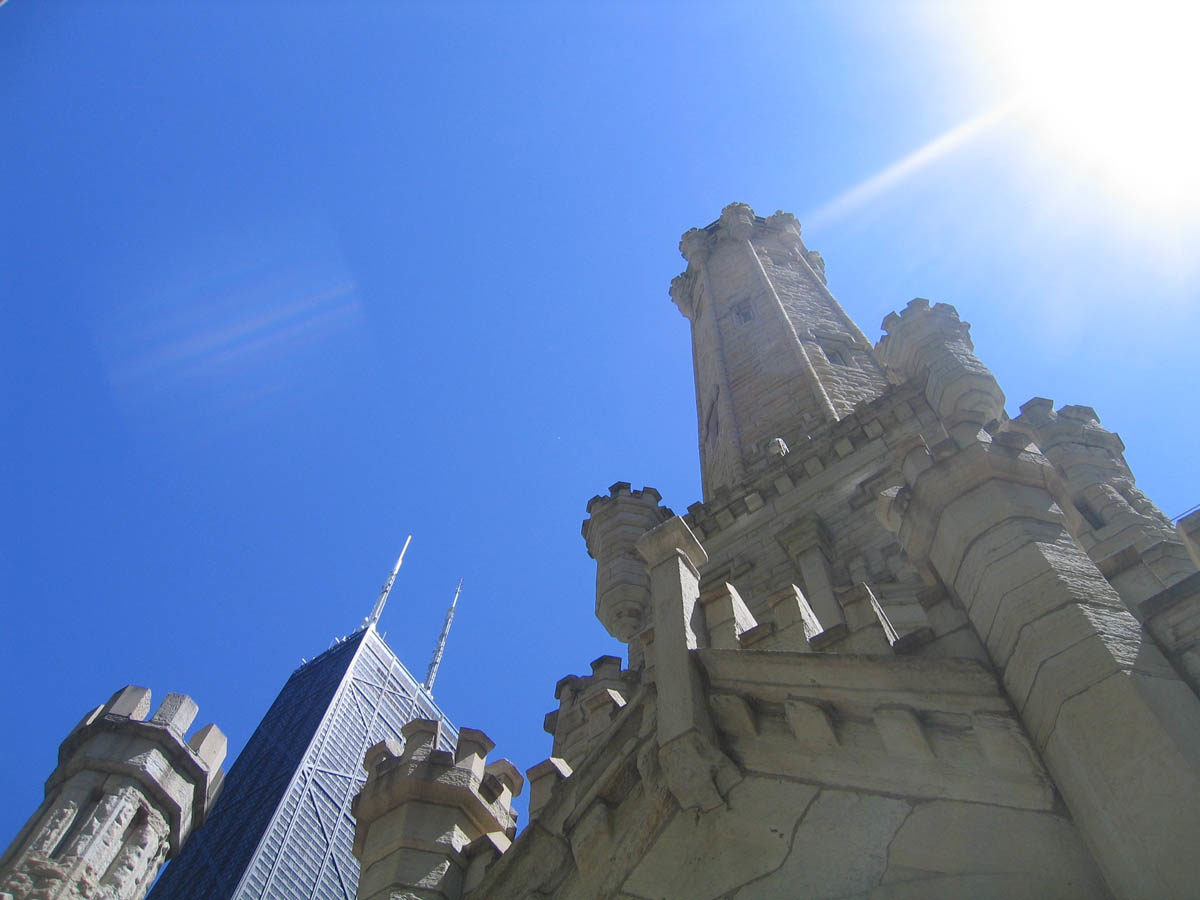The historic Water Tower stands tall above Michigan Avenue. Learn the story behind this Living Landmark.
This story is featured in Living Landmarks of Chicago, a fascinating book that brings landmarks to life. Get your copy today!
In a city of symbols, the one that most emphatically says “Chicago” is the historic Water Tower.
One of the few buildings to remain standing after the great Chicago fire, the tower and pumping station are portrayed as representatives of the city’s indomitable spirit. Their symbolism goes deeper than surviving the fire, though.
Sixty-four feet deeper.
It didn’t take long after Chicago incorporated for its citizens to realize they had a water problem. With a river flowing around and through the city into an inland sea, you’d think water would be the least of their worries. However, that river, and the fact that it emptied into the lake, was precisely the issue.
When the town began, its riparian location probably seemed perfect. Well, not exactly perfect. There was that whole stinky swamp issue.
But easy access to fresh water was certainly a selling point. Not only could they drink it and bathe with it, but they could also dump stuff into it – like trash, offal, and sewage – and watch it flow right into that giant body of water, never to be seen again.
Using the river as a dumpster seemed like a good idea at the time, but the population kept growing. In 1842 there were 4,500 residents. In 1851, 35,000. And by 1860, more than 100,000 people lived in Chicago. All of them needed to drink water, and all of them put things, dirty things, back into the water.
City officials realized early on the need for water works, and in 1842 they hired a private firm to build a pumping station to pull fresh water in from Lake Michigan. This firm installed the station at Michigan Avenue and Lake Street with a pipe that extended 150 feet into the lake.
That wasn’t nearly far enough. Not only did trains soon begin bringing people by the carload, they also brought livestock. Industries, like Cyrus McCormick’s reaper manufacturing plant, set up shop along the river. There were flour mills, grain elevators, and packing houses.
It was a free-for-all of expansion, and all of the residential and industrial waste stagnated in the streets until it went right into the drinking supply.
Sounds lovely, doesn’t it?
In 1851, the city built its own water works, moving the pumping house to Chicago Avenue and Pine Street and installing a 600-foot pipe. They thought – get this – that their new system would sustain them for another 15 years, which is when they projected the population would reach 100,000.
They hit that number in nine, and even a second pumping station in 1857 couldn’t stem the tide of typhoid fever, diarrhea, cholera, and other water-borne diseases.
Ellis Chesbrough, to the rescue.
He’d already convinced Chicagoans to raise their city by ten feet, which would be no easy task now, let alone in the 1850s. His plan was to build the brick sewers above ground level, cover them, and raise the existing buildings to the new street level. Gravity would then work its magic.
His system worked to get the sewage out of the street, for the most part, but it still dumped all that excrement and filth into the river, which went into the lake, which was pumped into the city so people could drink it.
They needed a new pumping station, and this time, they were serious. Chesbrough proposed a two-mile tunnel leading to a water intake crib.
Remember, this was in the 1860s, and his proposal meant digging a tunnel sixty-four feet below the surface of the lake that would connect the crib, itself a massive undertaking, to a brand new pumping station. But hey, if Chicagoans could raise a city by ten feet, they could do this. It took a little less than three years to complete the tunnel and crib.
Next up was the Chicago Avenue Water Tower and Pumping Station. The city tapped prolific architect William W. Boyington to design the complex.
Mr. Boyington had a thing for Medieval castles and he decked out his tower with buttresses, battlements, turrets, parapets, and spires. Cloaked in pale yellow Joliet limestone, when the structures were completed they fairly screamed GOTHIC!

One 19th century celebrity hated Boyington’s design. At an appearance in Chicago in 1882, Oscar Wilde sputtered: “Your Water Tower is a castellated monstrosity with pepperboxes stuck all over it. I am amazed that any people could so abuse Gothic art and make a structure not like a water tower but like a tower of a medieval castle. It should be torn down.”
Most people loved it, though. Lady Duffus Hardy, a British novelist and travel writer who visited two years before Wilde, wrote: “The new water works are the most beautiful illustrations of the vagaries of the architectural brain. . . . Never were so many cupolas and buttresses, pinnacles and towers grouped together on one spot; none but a true artist could have arranged them into so harmonious a whole.”
After a visit in 1928, when White Castle founders Walt Anderson and Billy Ingram opened their first Chicago store, they designed the franchise to resemble the iconic tower.
The city was ready. In addition to wanting water that wouldn’t kill them, they also wanted it to be fish-free. A tongue-in-cheek article in the Chicago Daily Tribune from January 14, 1867 said: “…those who have had small fish brought to their houses several times a day, gratis, will be obliged to patronize fish markets, and pay for all the fish they carry away.”
On March 25, 1867, the city celebrated the formal inauguration of the Great Lake Tunnel with a parade and a cornerstone ceremony. In 1869, the water works opened by the shores of Lake Michigan.
Two years later, the Chicago Avenue Water Tower became a symbol of the city’s spirit for another reason, the reason Chicagoans think of today: Boyington’s Joliet limestone survived the Great Chicago Fire.
At 182 and a half feet, the tall tower was a beacon of hope during reconstruction.
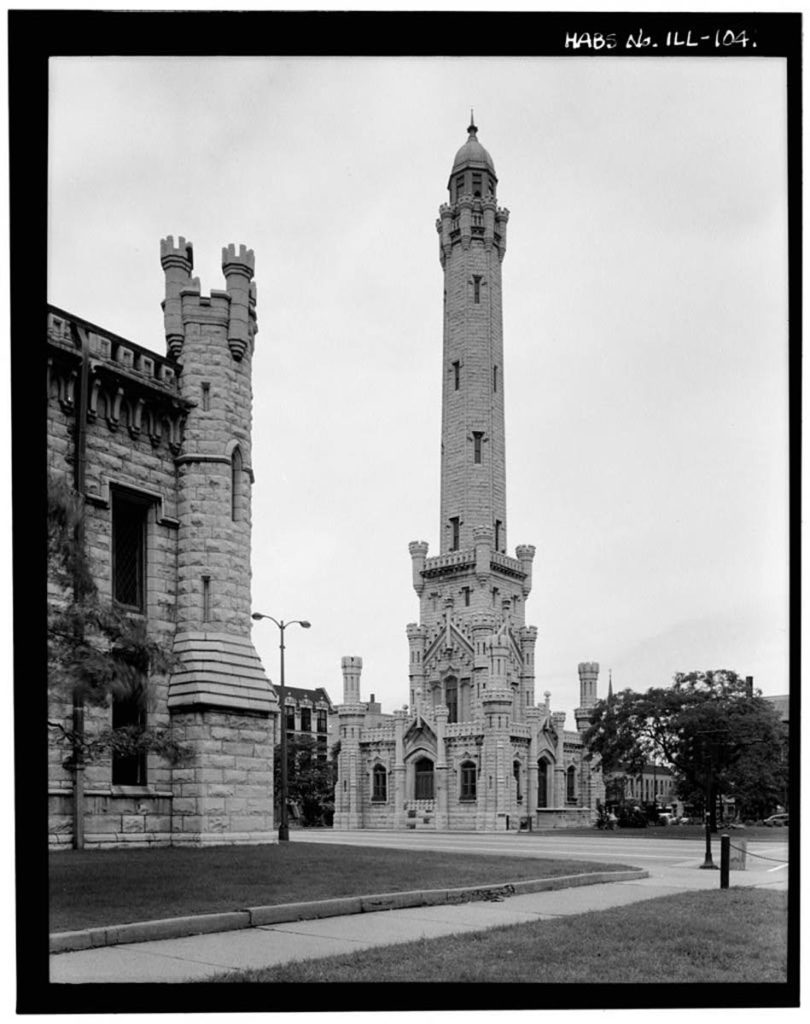
Despite all of the expense, effort, and innovation, the water works could only be used for another ten years before another tunnel was needed. Engineers finally realized that reversing the flow of the river would be the only way to fix Chicago’s water woes. That happened in 1899, and by 1906, although the pumping station could still be used, the Chicago Avenue Water Tower was obsolete.
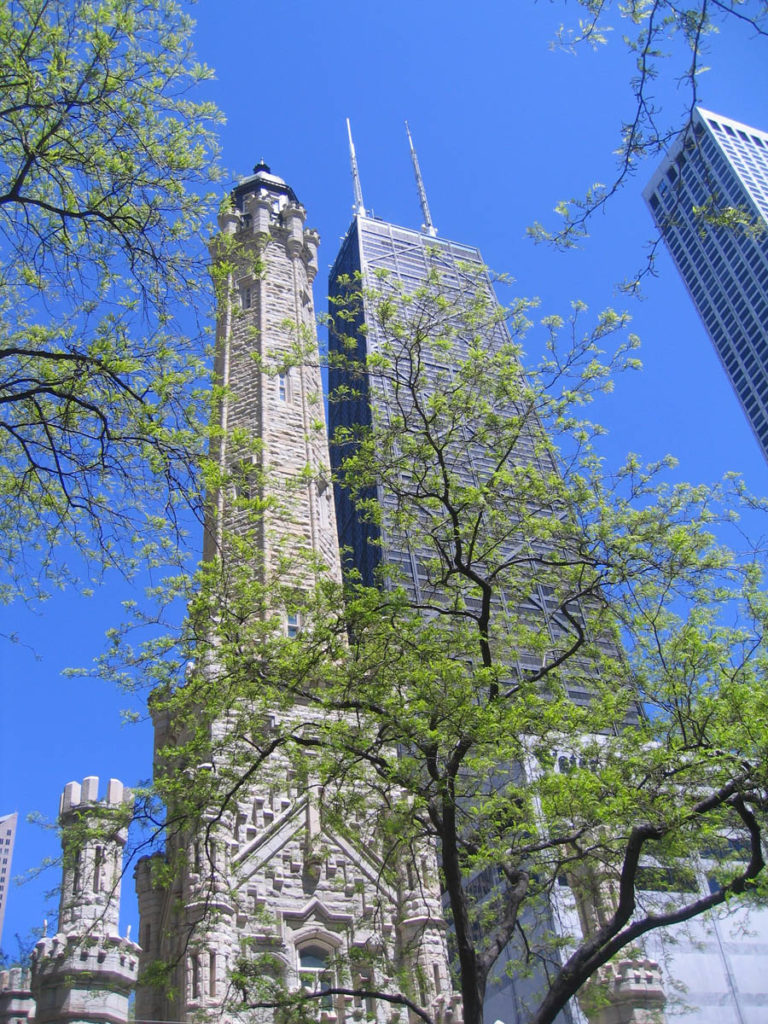
Are you enjoying this excerpt from Living Landmarks of Chicago? Wonderful! Get your copy today.
The tower may have survived the fire, but it still wasn’t safe. Over the years there would be calls to tear the tower down, but each time the public was able to preserve it. There was even talk of moving the tower, but preservationists, including the Chicago Historical Society, stepped in to stop that nonsense. They convinced the city to reroute Michigan Avenue to keep the cherished landmark right where it is.
There’s no need to worry about future threats. In 1969, the Chicago Water Tower became the first water works to be designated as an American Water Landmark. In 1971 it became a Chicago Landmark, and in 1975 both the tower and pumping station were inscribed to the National Register of Historic Places.
Historic Water Tower and Pumping Station Today
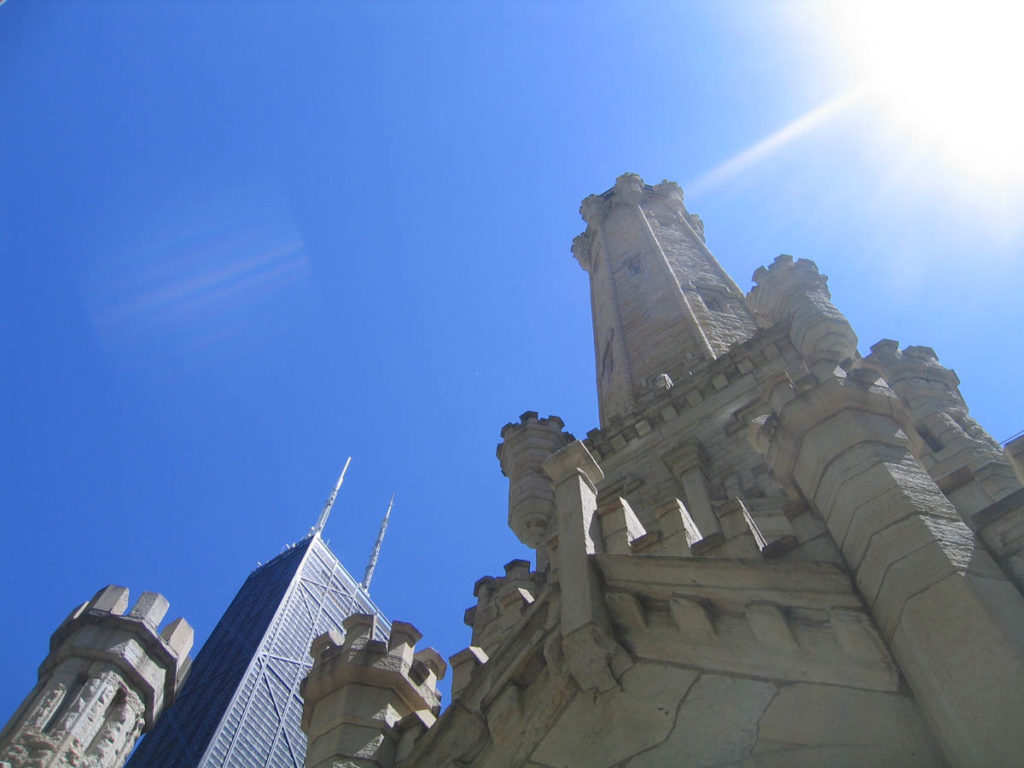
The historic water tower is surrounded by soaring buildings now, but it still stands tall and represents a city that simply will not give up. Inside, the tower contains the City Gallery. This is a free gallery in the wide base of the tower that features the work of local photographers and artists and is open seven days a week. Temporarily closed.
Across Michigan Avenue, the pumping station is doing what Chesbrough imagined back in the 1860s, and a little more. In addition to bringing in fresh water (from much further out in Lake Michigan), the nationally-recognized Lookingglass Theatre presents plays and musicals inside the historic building.
Chicago Water Tower; 806 North Michigan Avenue, Chicago, IL 60611, chicago.gov
Chicago Pumping Station; 821 North Michigan Avenue, Chicago, IL 60611
